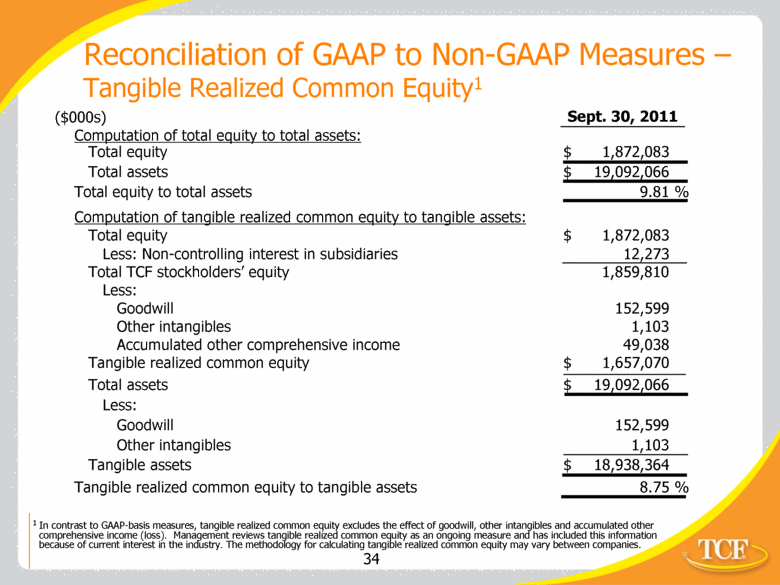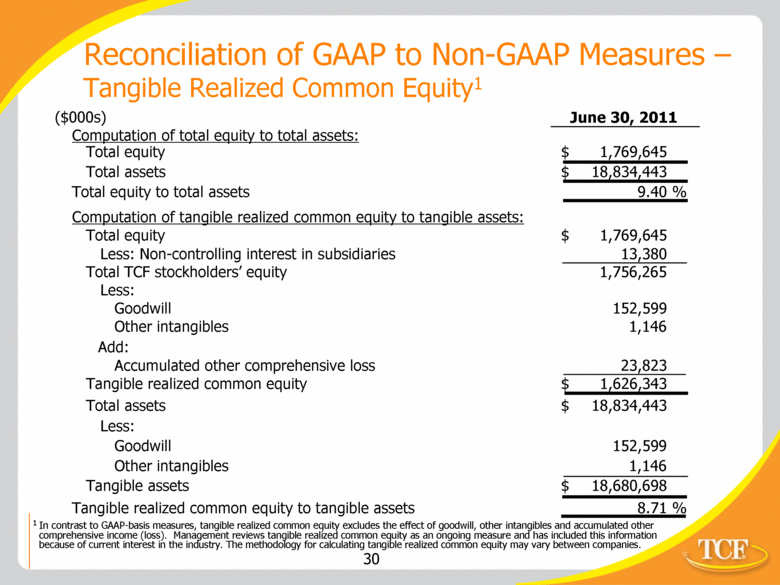Accumulated Other Comprehensive Income Opting In or Out
Post on: 6 Сентябрь, 2015 No Comment

Most community banks when filing their December 2014 Call reports in January or early February 2015 will need to determine whether they want to opt-in to or out of including Accumulated Other Comprehensive Income (AOCI) in regulatory capital. The new capital regulations issued in mid-2013 allow almost all community banks the option of including or excluding AOCI from the determination of regulatory capital. It is expected that just about every community bank will opt-out. This decision can have significant impact on a banks operation.
What is Accumulated Other Comprehensive Income?
AOCI is used to sum up unrealized gains and losses on items that have not yet been settled. In other words there could be a loss or gain in a certain financial instrument if liquidated immediately in the current market place, but if held on to, there is no direct effect on net income. The most important example is a security held in an Available for Sale (AFS) basis that has a current market value above or below the stated value on the books of the institution. If the security is sold, currently this gain or loss would affect net income, but if not sold the difference between book and market is simply an unrealized amount. Under current accounting standards, this unrealized level is considered part of AOCI, which can affect book but not regulatory equity.
Every quarter, if not more frequently the market value of the security changes and thus the AOCI level. If AOCI is positive this will increase the banks GAAP capital and if the institution does not opt-out their regulatory capital. If, however, the value of the security declines, the AOCI can turn negative and will reduce a banks capital ratios. While unrealized gains or losses on investment securities represent the vast majority of most banks AOCI, there are several other components that can come into play, this includes:
- Accumulated net gains (losses) on cash flow hedges
- Cumulative foreign currency translation adjustments and foreign currency transactions
- Certain pension liability adjustments
The main driver of AOCI, however, is the unrealized gains or losses on AFS securities. As of June 30, 2014, over 88% of all banks AOCI was composed almost exclusively of AFS unrealized gains or losses. Or, in other words what happens on movement of interest rates and their effect on banks investment security values determines AOCI.
Why is This Important?
AOCI can, and does, change on a regular basis. The first chart below shows how unrealized gain or loss to tier 1 capital changed between the very low interest rate environment of March 2013 and the higher intermediate yields at the end of December 2013, and then the slight fall in interest rates by March 2014. As can be seen there were a number of institutions where the absolute unrealized loss to Tier 1 capital was in excess of 10%. Due to the further declines in intermediate yields by June 2014, the percentage of banks with significant negative AOCI and unrealized losses has further declined as shown in the second chart.
Thus for most banks that choose to opt-in, their regulatory capital would have improved in the first half of 2014, even absent of any profit, due to the increase in AOCI. However, changes to unrealized gains or losses to these banks can lead to volatility in regulatory capital. Most banks do not desire this volatility, in good times and especially not in bad times.
What about Held to Maturity on all Securities?
One way of reducing unrealized gains or losses is to avoid having securities available for sale. This can primarily occur in one of two ways, the first is to invest any liquidity in fed funds sold, very short term money markets, or deposits at other banks, the Federal Home Loan Banks or balances at the Federal Reserves. A surprisingly large number of banks (almost 10% of the total) have taken this route. While many of these banks are small, there are several institutions with assets in excess of $1 billion.
The other means is to purchase investment securities and just designate them as Held to Maturity (HTM). The bank is not able to sell these securities prior to maturity, except for a very limited number of situations. Sale prior to maturity generally means all other securities of similar type must be reclassified as AFS. Also, a sale of HTM securities tends to cause conflicts with outside accountants and regulators. Thus, HTM may reduce the liquidity of the investment portfolio, but it also reduces volatility in unrealized gains or losses.
Most banks today have only a limited number of HTM securities. These are often small local municipal issuance with limited marketability. They may also include certain asset backs or trust preferred which cannot be readily sold. In fact as of June 30th, only about 18.5% of investment securities at community banks are designated as HTM. It is the potential for reduced liquidity that rightfully causes many banks to limit the number of HTM securities. While many HTM securities can be used for repurchase agreement collateral, that market can be limiting, particularly during a period of stress.
Interest Rate Volatility and Unrealized Losses

The issue is not much of a factor in the current interest rate environment (October 2014), but becomes critical as yields increase. As noted, in December 2013 many institutions received a taste of the effects of rising interest rates. A couple of simple examples can demonstrate what rising interest rates means. Lets assume that a bank has $500 million of regulatory assets and a Tier 1 capital ratio to assets of 10% ($50 million of capital). Assume further that 20% of the assets are in five year AFS bonds with a coupon of 2% with current yields at the same level. There are no other investment securities. If the bonds were purchased without any premium or discount, book and market would be the same. However, if yields immediately increased in increments of 100 basis points (bps) up to 400 bps, the market value of the bond would decrease and the unrealized loss would increase. As a percentage of Tier 1 capital, this ratio would grow appreciably.
The first table shows this effect:
The next two tables shows the effects if the bonds had a maturity of ten and two years.
In the case of the two year bonds or the equivalent of a portfolio with a duration of about 1.9 years, the results are, perhaps, manageable. For the portfolio of ten year bonds, or a duration of about 8.6 years, it would be best to hope that securities as a percentage of total assets is 2% and not 20%. A more explicit way of saying this: make sure your resume is up-to-date.
The graphs below show these results for a random sample of banks based on estimates of their portfolios. These are all community banks, generally with assets of between $500 million and $4 billion. As can be seen, most of these banks do not have an issue if interest rates remain at present (October 2014) levels. A few of them are in pretty good shape, even with a rise of 400 bps. It should be noted that this is a random selection of banks and is not meant to represent what will happen to all banks. However, there will certainly be a number of banks where a rise in interest rates of 3 or 4% will have a significant negative effect on their unrealized AFS gains and losses.
The Sting
The movie of the same name was very popular several years ago. Unfortunately banks could find themselves in a similar situation, although perhaps without the false arrest. After all, the question that might be asked today is: why worry? Early next year just about every bank that can opt-out of including AOCI and thus unrealized AFS security losses in regulatory capital will do just that. Thus, in theory, changes in AOCI, whether positive or negative will have no effect on a banks capital ratio. While the original bank capital proposal included AOCI, the final regulation made it optional. As many have argued, there is currently no requirement to book changes in the market value of the loan or deposit portfolio in regulatory capital. Why should securities be treated differently?
So, all is good. In fact, why even write this article? Well, here comes the sting. Unfortunately, although the capital regulations permit the opt-out provision, there is an addition provision that states:
Notwithstanding the availability of the AOCI opt-out election under the final rule, the agencies have reserved the authority to require banking organizations to recognize all or some components of AOCI in regulatory capital
It further states that:
The agencies will continue to expect each banking organization to maintain capital appropriate for its actual risk profile, regardless of whether it has made an AOCI opt-out election. Therefore, the agencies may determine that a banking organization with a large portfolio of AFS debt securities, or that is otherwise engaged in activities that expose it to high levels of interest-rate or other risks, should raise its common equity tier 1 capital level substantially above the regulatory minimums, regardless of whether that banking organization has made an AOCI opt-out election
Or a simple example may suffice. A bank has a comfortable level of capital well above capital minimums, say 20% higher. Rates rise 300 bps while investment portfolio duration and size remains relatively unchanged, after all no one wants to sell bonds that might be priced below book. The bank has a profile similar to the average of the eleven banks shown above. In this scenario, the statement adequately capitalized is not so bad, may be used more frequently at that bank. The Sting, doesnt have to happen to many banks. One just wants to make sure that their institution is not one of them.














